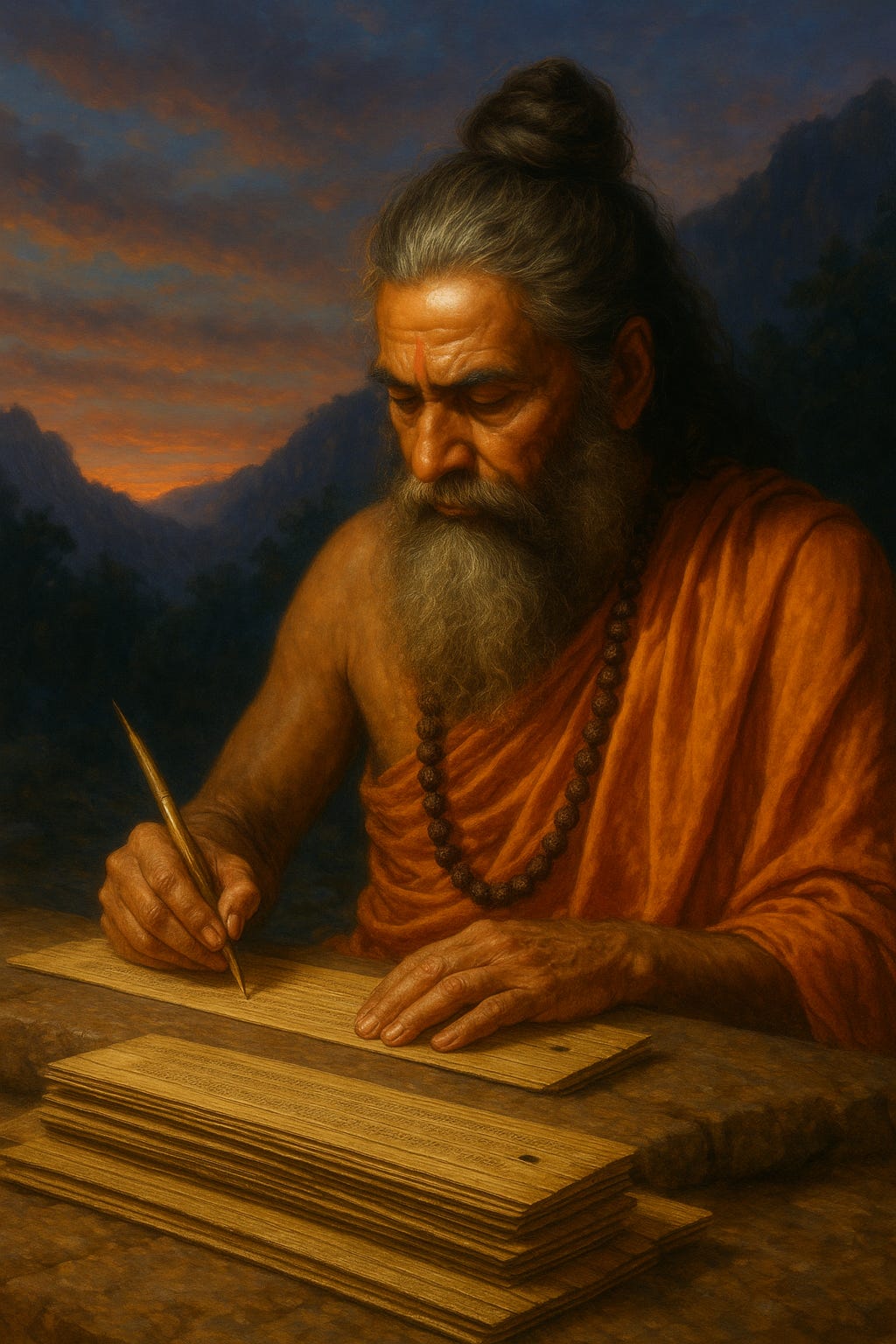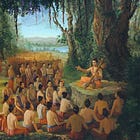The six philosophical systems from the Vedas
Originally, there was an unified system of understanding of the Vedas, but with time, scholars started disagreeing, and six separate systems emerged. Which are them?
In His purport to SB 1.1.7, Srila Prabhupada explains that:
"Śrīmad-Bhāgavatam is a natural commentation on the Brahma-sūtra, or the Bādarāyaṇi Vedānta-sūtras. It is called natural because Vyāsadeva is author of both the Vedānta-sūtras and Śrīmad-Bhāgavatam, or the essence of all Vedic literatures. Besides Vyāsadeva, there are other sages who are the authors of six different philosophical systems, namely Gautama, Kaṇāda, Kapila, Patañjali, Jaimini and Aṣṭāvakra. Theism is explained completely in the Vedānta-sūtra, whereas in other systems of philosophical speculations, practically no mention is given to the ultimate cause of all causes. One can sit on the vyāsāsana only after being conversant in all systems of philosophy so that one can present fully the theistic views of the Bhāgavatam in defiance of all other systems."
The six philosophical systems that Srila Prabhupada mentions here are:
1- Nyāya, by Gautama Ṛṣi,
2- Vaiśeṣika, by Kaṇāda Ṛṣi,
3- Sāṅkhya, by the atheistic Kapila,
4- The system of mystic yoga of Patañjali,
5- Karma-mīmāṁsā, by Jaimini,
6- The impersonalism of Aṣṭāvakra and later Śaṅkarācārya.
Different philosophies that come from India can be divided into two groups: āstika (philosophies that follow the Vedas) and nāstika (philosophies that reject the Vedas). Different from nāstika philosophies like Buddhism, Jainism, and the atheistic empiricism of the followers of Cārvāka (philosophies that reject the Vedas), the sad-darśanas, or the six systems of philosophy mentioned here by Srila Prabhupada are considered āstika philosophies because they all accept the Vedas as authoritative.
Originally, these six philosophical systems were different parts of a unified system of understanding of the Vedas, but with time the scholars started disagreeing and the systems became separated, with none of them having a complete view of the goal of life.
The resultant six philosophical systems are predominantly atheistic, studying different aspects of the material nature separately from the Supreme Lord. Logic, meditation, and so on are part of our spiritual studies and practice, but when disconnected from Krsna, they become just materialistic philosophies that have little purpose in bringing one back to Godhead.
It seems that these six systems also become separated in other cycles of creation of the universe, serving different classes of materialistic persons. Just like Lord Śiva comes as Śaṅkarācārya to establish the Māyāvāda doctrine and thus bewilder the atheists, different philosophers propound these different philosophical systems at different times for different purposes.
So, what do these six schools teach?
1- The Nyāya system deals with reasoning and logic, establishing rules of philosophical debate, identifying subjects for discussion, etc. The main concern is in establishing the conditions for obtaining correct knowledge (pramāṇa), and the means of acquiring valid knowledge, analyzing the nature and source of different types of knowledge to determine their validity or non-validity, and so on. Logic has a very important role in the study of the Vedānta-sūtra, for example, since it is full of logical arguments that lead us to a conclusive understanding of the Upaniṣads. However, when separated from the authority of śāstra and devotion to the Lord, logic becomes merely a tool for debate and the exercise of intellectual ego.
2- The Vaiśeṣika system, propounded by Kaṇāda (and often discussed alongside Nyāya), studies the material world in great detail, determining its causes and effects in order to destroy material suffering. It holds that ignorance (avidyā) is the root cause of misery and concludes that liberation (mokṣa) is attainable through the cultivation of correct knowledge. The main focus in this school is on studying the cause and effects of the material creation, and especially the material elements and their attributes. Their conclusion, however, is that the atomic combination of material elements is the original cause of creation. This theory, called Paramāṇuvāda, is similar to what is believed by modern physicists.
3- The Sāṅkhya system is an analytic study of the material elements. Although it bears the same name as the ancient system introduced by Lord Kapila, the son of Devahūti, the modern system was propounded by another Kapila, who taught an atheistic interpretation.
4- The process of mystic yoga is offered in the Vedas as a bona fide process of self-realization. Krsna himself describes the system of aṣṭāṅga-yoga in the Bhagavad-Gita. Originally, yoga means to link our consciousness with the Supreme Personality of Godhead, reviving our original spiritual identity. The system that is counted amongst the six philosophical systems is the pātañjala-yoga, propounded by Patañjali in his pātañjala-yoga-sutra. This system is focused on examining the nature of the mind, its workings, the impediments it creates, the causes of material suffering, and so on. The ultimate goal in this system is kaivalya, or impersonal liberation.
5- The system of karma-mīmāṁsā was propounded by Jaimini. This is a philosophical school that stresses fruitive activities. For them, the results of one's material activities are supreme, and if there is a God, he is nothing more than an order supplier, who just delivers the results of one's karma. According to this system, there is no real need to become a devotee of the Lord. One should just follow moral principles and perform pious activities, and thus be happy in this world by receiving the results of their good karma. Vyāsadeva quotes Jaimini a few times in the Vedānta-sūtra (although not always in agreement with him), and Baladeva Vidyābhūṣaṇa explains in his commentary that in reality he was a devotee who wrote instructions to guide common people who lacked higher qualifications.
6- The last system is the Vedanta school, presented by Vyāsadeva (Bādarāyaṇa) in the Vedānta-sūtra, which brings the final conclusion of the Vedas, further explained in the Srimad Bhagavatam. However, other sages have also presented their own interpretations of Vedānta. The chief amongst them was Aṣṭāvakra, whose Aṣṭāvakra-gītā reflects an impersonalistic understanding of the Upaniṣads. His conclusions are very close to the Advaita Vedānta later systematized by Śaṅkarācārya, which declares the material world to be false, the self to be one with Brahman, and liberation to consist in merging into the impersonal Absolute. Such teachings represent only a partial understanding of the Vedas, since they stop at the Brahman realization and fail to reach the ultimate truth of Bhagavān, the Supreme Person. Both offer an incomplete, impersonal interpretation; the main difference is that Śaṅkara based his philosophy on an interpretation of the Vedānta-sūtra of Vyāsadeva, while Aṣṭāvakra taught based on his own book.
Vyāsadeva was well aware of all these different philosophical systems and strived to offer the proper conclusion of the Vedas in his own school, propounding the philosophy of Brahma-mīmāṁsā, or Vedānta, which brings the ultimate conclusion of the absolute truth.
Vyāsadeva appeared at the end of Dvāpara-yuga to restore the correct understanding of the Vedas, which at the time had been covered by these different philosophies.
In the Bhagavad-Gita (15.15), Krsna mentions how he personally comes as Vyāsadeva to compile the Vedas and establish the Vedanta school at the end of Dvāpara-yuga: "I am seated in everyone’s heart, and from Me come remembrance, knowledge and forgetfulness. By all the Vedas, I am to be known. Indeed, I am the compiler of Vedānta, and I am the knower of the Vedas."
If you read this article to the end, give it a like. This makes Substack recommend it to more people.
Read also:






Thank you for sharing, Hare Kṛṣṇa.
Hare Krishna Prabhu 🙏 Very detailed descriptions of six philosophical systems , i always wanted to know that and by help of you today i know and got the idea. Thank you prabhu